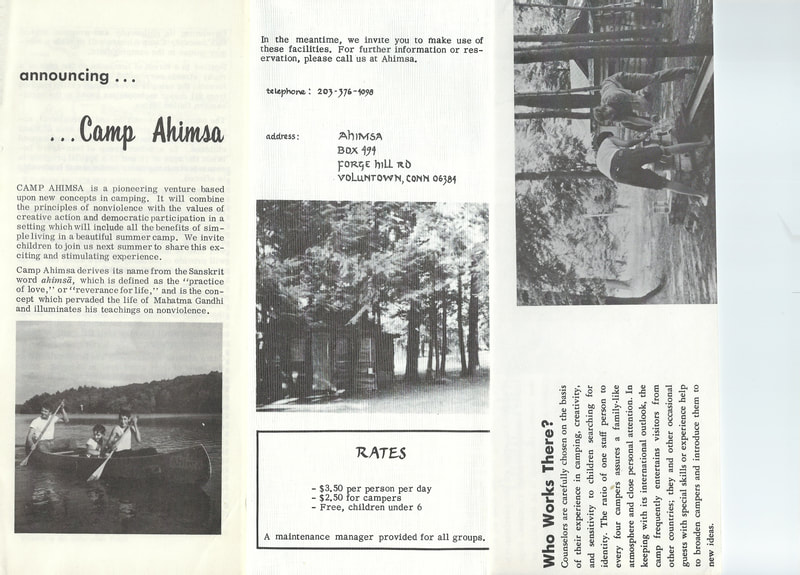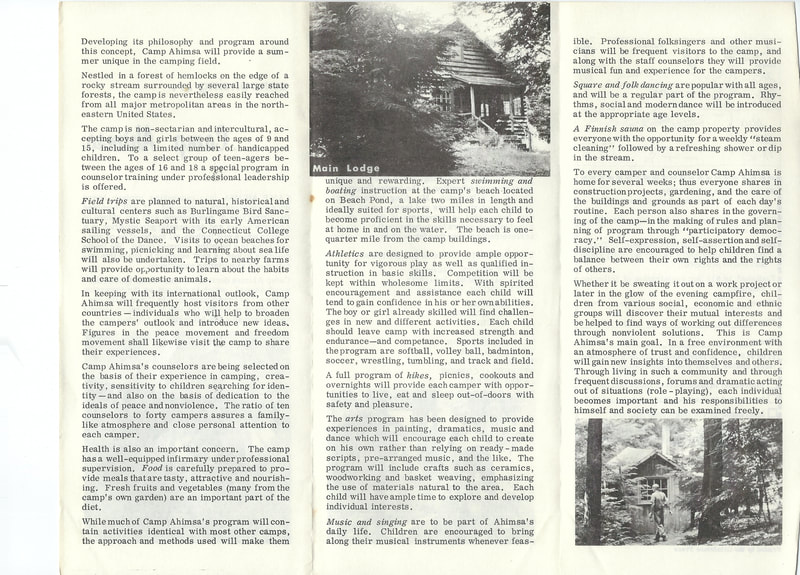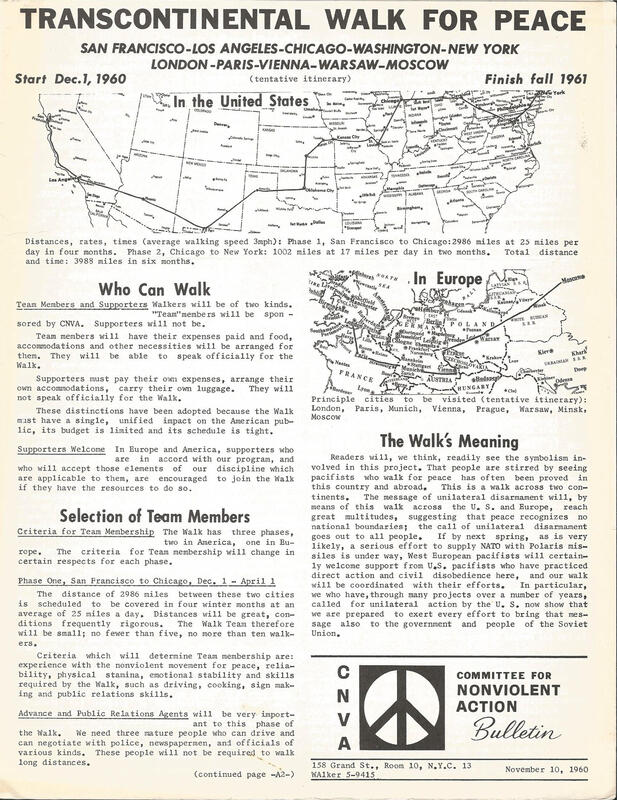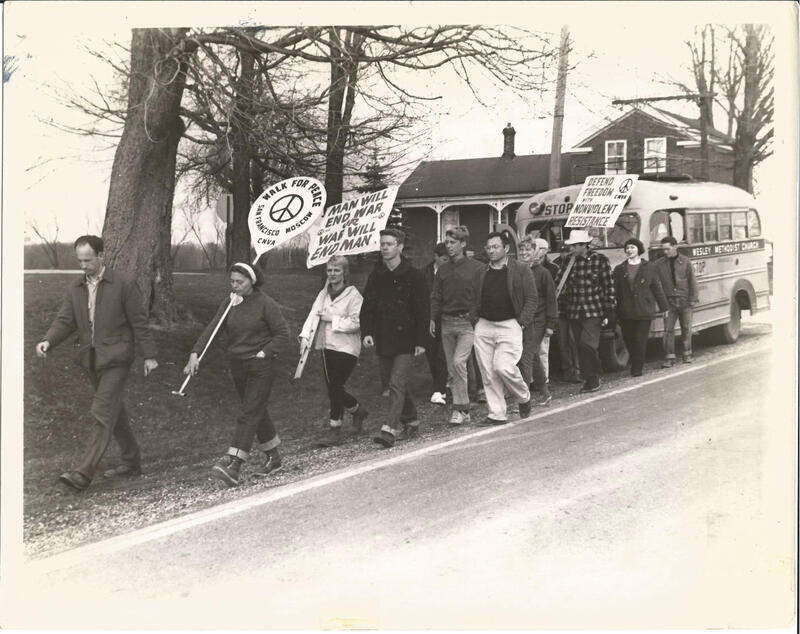|
(click here to view the original post on Facebook)
On this week’s Peace of History: We shine our spotlight on a curious building at the Voluntown Peace Trust: the Yurt. This particular building was gifted by Jane and Kit Johnson, long time members of the VPT community. We are eager to share this unique gift with others already in our community as well as with those who are simply curious about what we do. Standing a couple feet off the ground, the design of this 16 foot diameter circular structure is inspired by the traditional dwellings of nomadic peoples of the Eurasian Steppe. Traditional yurts are usually made from skins or felt arranged over a precisely constructed wood or bamboo latticework frame. Sharing some similarities with the indigenous North American tipi, traditional yurts were made to be light but sturdy, and designed so that the inhabitants could collapse them, carry them away, and then set them up again at a new location quickly and easily. Ranging in size from several feet to one hundred feet in diameter, yurts are used for a variety of purposes, from community gathering halls to homes. The concept of yurts was first imported to the West in the 1960s-1970s, and they have been adapted to the change in environment and in purpose. Generally designed as more permanent buildings than their Eurasian cousins, Western yurts are often made from hi-tech architectural fabrics, waterproof tarpaulin, insulation material, and sometimes metal frames. In North America, yurts are most often found on camping sites and on private homesteads. The Yurt at the Voluntown Peace Trust was in the Johnson's back yard in Stonington before being gifted to us. Kit built an insolated wooden floor that is made of 6 wedges for mobility. Kit and Jane installed their own insulation (see the silver colored ceiling and hung cloth on the walls to make it feel more cozy.) Their son Ben lived in the Yurt for a time. Here are some of Ben’s own words describing his experience living in the Yurt. "As someone staying in there by myself, I found it to be an incredibly calming place to be. Unlike a house, it wasn't totally disconnected from the elements. When it rained--the top of the yurt was like a giant drum. When the train went by a mile away, you heard it. When the peeper frogs were out...when the buoys in the sound gave their slow, lonely honk. When a breeze would pass through or a bumble bee would buzz by. When you are in the yurt, you are in something that amplifies its own environment. There's something very powerful about that. [...] If you are staying in the yurt, you should remember that much more than a house it is like our own spirits. You have to take an active role in caring for it, and in caring for yourself in it. There will always be something to do--a log to put on the fire; a bug to shoo back outside; a window to close or open. But in doing those small things you will find great comfort, quiet, peace, great oneness with the world and with yourself." Attached is an interior panoramic of our Yurt, in which you can see the wood latticework frame, the futon and pull out couch, and a few wall hanginging left as gifts by past guests. To learn more about our Yurt, including more about Ben Johnson’s first-hand experience living in the Yurt, please visit our Rentals page on our website: http://www.voluntownpeacetrust.org/yurt.html (click here to view the original post on Facebook)
On this week’s Peace of History: We take a brief look at one of our most affordable and charming buildings availability for rent: Chuck’s Cabin. Not much historical documentation exists about the building, but we know some details about its past, and can make educated guesses about others. Built as a Finnish sauna during the migration wave into eastern Connecticut from New York sometime between 1920 and 1960, the building has an opening in the rock foundation for access under the sauna, and it originally included a hole in the floor where the woodstove and heating stones would have been. There is a small stream next to the building which has filled in with silt over the years, but it had formerly provided water for the sauna. Saunas were often one of the first buildings to be built by a Finnish family or small community when moving to a new place, and this one likely served either the Hebert family (the last owners of the property) or the family that owned the property before them. Since the sauna was so integral to traditional Finnish hygiene and culture, they were typically built to be rather comfortable and spacious, and it was not uncommon for them to include windows to let in natural light. After the establishment of the Voluntown Peace Trust, the sauna was repurposed as a temporary living facility and served that function for years. In the late 1990s, the building was repurposed again, this time by Chuck Matthei, the Executive Director of Equity Trust, Inc. when the organization was based at VPT. It was remodeled to be a year-round, Walden-esque cabin for Chuck while he continued his work of supporting community land trusts and other alternative economic systems. We will return to Chuck Matthei and the story of Equity Trust, Inc. at a later date. Chuck passed away in 2002 due to complications with cancer, but we still call the building that he called home “Chuck’s Cabin” in his memory. The interior is relatively unchanged from when Chuck lived there, and guests can appreciate the rich history of this little cabin: from the original wood panel walls from its days as a family sauna, to the little quirks and rustic hominess that Chuck added in his time. Next week: we will focus our spotlight on our final building currently available for overnight rentals: the Yurt! We’ll tell you about the traditional history of these buildings, and how we acquired this one. Attached is a panoramic photo of the interior of Chuck’s Cabin. If you are interested in renting this cabin full of history and charisma, please visit the link below: http://www.voluntownpeacetrust.org/rentals.html (click here to view the original post on Facebook)
On this week’s Peace of History: We begin a three-part series on some of the buildings available for rentals at the Voluntown Peace Trust, starting with the idyllic Ahimsa Lodge. Tucked away in the woods off of Forge Hill Road at the back of the 54-acre VPT property, Ahimsa Lodge is an exceptionally cozy cabin with a complete kitchen, woodstove, beds for up to 14 people, common rooms, and a dining room with excellent natural lighting that opens to a large back deck overlooking the babbling Bliven Brook nearby. The site has hosted youth and adult campers and visitors for decades, and we proudly continue the tradition. According to several sources, the site was originally a Finnish resort camp -- complete with a traditional sauna, recreation hall, cabins, and a main lodge. About 300,00 immigrants of Finnish descent came to the United States in the early 1900s, but from 1913 through to the 1920s, many Finns living in Brooklyn, NY began to move into eastern Connecticut to buy farms. According to members of the Finnish American Heritage Society, so many Finns moved to the area that by 1950, about a quarter of Voluntown’s population could claim Finnish ancestry. Many of these folks maintained Finnish social clubs to celebrate traditional holidays and practice recreation. But by the 1960s, the younger generation had somewhat lost interest in these Finnish heritage organizations, and like so many other sites like it, the camp that bordered the Peace Farm to the north became available for sale. In October of 1965, when the Voluntown Peace Trust bought the lodge and the 5-acre property it sat upon, the site and lodge was renamed Ahimsa (from Sanskrit meaning “practice of love” or “reverence for life”), the concept that suffused Mahatma Gandhi’s practice and philosophy of nonviolence. VPT began using the lodge to host large weekend meetings soon after the land purchase, with plans to develop a youth summer camp for the following year. Although similar to other summer camps, with activities like sports and other recreation available, what was unique about this camp was the central philosophy found in the name itself: Ahimsa. Everything returned to the basic concepts of love, peace, and respect for life. Since the 1990s, Ahimsa has been the home of an annual summer camp for urban youth put on by the Hartford Catholic Workers. Inspired by the same philosophy as the original Ahimsa summer camp, the current summer camp gives inner-city children an opportunity to immerse themselves in an environment of natural tranquility. We are proud to continue this tradition of celebrating, maintaining, and sharing the natural beauty of Voluntown. Attached with this post is the original flyer advertisement for the 1966 Camp Ahimsa program. Sources: CNVA Direct Action newsletters, https://www.nytimes.com/2005/07/31/nyregion/the-finnishamerican-record-keepers.html Next week, we will explore the history of Chuck’s Cabin, a much smaller but incredibly charming building at VPT. And don’t forget: you can rent Ahimsa for yourself! Visit the link below to learn more. http://www.voluntownpeacetrust.org/rentals.html (click here to view the original post on Facebook)
On this week's Peace of History: We celebrate the anniversary of the “San Francisco to Moscow Walk for Peace,” an incredibly ambitious transnational nuclear disarmament effort which began in December of 1960. Earlier that year, as the Polaris Action summer campaign wound down, several Committee for Non-Violent Action (CNVA) members decided to create a permanent CNVA presence in southeastern Connecticut. These folks would go on to found the Voluntown Peace Trust. But while the CNVA members who stayed in Connecticut decided to focus on the local communities of New London and the surrounding areas, other CNVA members looked toward organizing an ambitious international disarmament campaign. The CNVA, including Bayard Rustin and A.J. Muste, had been involved in other transnational conferences and campaigns for nuclear disarmament, most notably a protest in December 1959 against a French nuclear bomb test in the Sahara Desert, not far from Ghana. Many members of the CNVA were encouraged by the widespread popular Ghanaian support of the Saharan protest, and CNVA was encouraged further by the growing anti-nuclear weapons movement that was especially gaining traction in countries “unaligned” or seeking independence from the imperial powers. But it was the experience of workers at General Dynamics/Electric Boat telling the protestors to “tell it to the Russians” that provided the inspiration for the next campaign after Polaris Action: a “Walk for Peace” from San Francisco to Moscow to encourage disarmament. Within a few short months, CNVA had organized a 310-day, six thousand mile walk that crossed the span of North America, the width of Europe, and ended in Moscow. Activists from eight different European countries would come to join the American walkers, which included the then seventy-six year-old legendary organizer A.J. Muste, as they pressed on east. In most countries, on both sides of the Iron Curtain, the walkers received hospitality and opportunities to present their arguments for unilateral disarmament to average citizens. The only country to reject the walkers was France, but supporters within the country walked the French part of the route themselves, thus doing their part to fulfill the entire itinerary. When the walkers finally reached Moscow, the Soviet government permitted them to hold a 2-hour public vigil in Red Square to protest the Soviet Union’s continued nuclear tests -- the first peace demonstration in the city organized by a Western group since the founding of the Soviet Union. One curious note should be added: this San Francisco to Moscow Walk for Peace was one of the earliest international applications of the now-ubiquitous circular peace symbol. Originally invented in the U.K. in 1958 for the British nuclear disarmament campaign, the symbol was quickly introduced to activists in the United States by Bayard Rustin (best known as the organizer of the 1963 March on Washington) who had attended the march where it was first used. The symbol rapidly gained popularity among American nuclear disarmament activists, and was prominently displayed that same year on one of the sails of The Golden Rule -- the CNVA-crewed ship that pulled various disarmament publicity stunts, frequently finding its way into the photos in newspapers. On the Walk for Peace, several signs carried by the walkers prominently featured the round peace symbol, and as they walked across Europe, these activists may have spread the use of the symbol to these other countries, as well, although that is difficult to confirm. For more information on the Saharan Protest against nuclear weapons testing in Africa, which heavily inspired the CNVA, you can learn more at the Global Nonviolent Action Database: https://nvdatabase.swarthmore.edu/content/international-team-campaigns-against-nuclear-testing-africa-sahara-protest-1959-1960 Next week: We will begin a short series on some of the lovely buildings available for rent at the Voluntown Peace Trust. |
AuthorWrite something about yourself. No need to be fancy, just an overview. Archives
March 2023
Categories |







 RSS Feed
RSS Feed